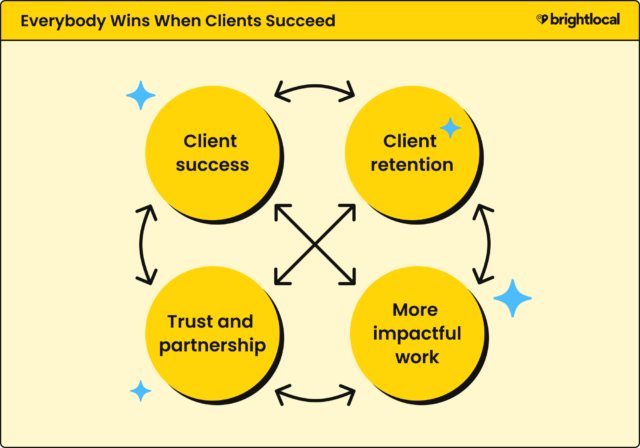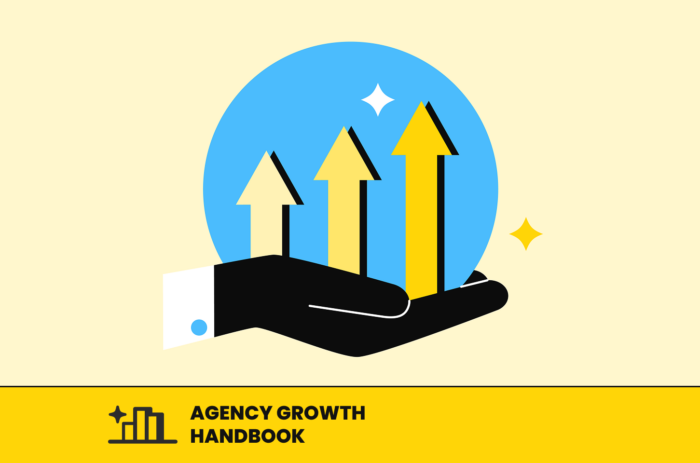This article is from our Agency Growth Handbook—a collection of guides created to help local SEO agencies grow and succeed. It is chapter seven of ‘Part 3: Retention & Growth’.
Let’s be honest. Most of us have been on the receiving end of a sales pitch we didn’t ask for. It’s rarely a good feeling.
So, it’s understandable that the word ‘upselling’ might make you feel uncomfortable. You don’t want to sound like you’re pushing extra work for the sake of it. And your clients… they can usually tell when something’s being sold to them.
But real upselling isn’t about pressure. It’s about timing, empathy, and spotting where something extra could make a genuine difference.
It’s not about you. It’s about helping clients get closer to something they’ve already said they want. Maybe it’s more leads. Maybe it’s more traffic. Maybe it’s finally outranking the competitor they keep bringing up.
This guide shows you how to approach upselling in a way that feels natural, helpful, and easy to say yes to.
Clients Don’t Care What You’re Doing, They Care About Results
We often want to explain our process. To walk through everything we’ve done behind the scenes, from fixing crawl issues to running content audits to tweaking schema. It makes sense. We’re proud of the work.
But the truth is, that’s not what most clients are focused on.
They’re wondering:
- “Is this going to help us get more sales?”
- “Will this bring in the inquiries we need?”
- “How will this affect local footfall?”
- “Is this going to move the needle?”
So, when you upsell, speak their language. Don’t say, “We could run a technical audit to improve your crawl depth.” Try, “We’ve spotted a few issues that might be stopping your key pages from showing up in search. Fixing these could help your best products get seen more often.”
One of our clients was frustrated about a lack of leads. Instead of launching into form performance or GA4 set-ups, we said:
“We’ve reviewed your landing pages. A few small changes could bring in around 15 to 20 extra monthly calls.” That felt real to them. It connected the dots.
Clients trust you more when they understand exactly what’s being fixed and what that fix means for their bottom line.
Spotting the Right Moment to Upsell
The best upsells don’t come out of nowhere. They often show up in the things your clients say during calls or emails.
A client might say:
- “We thought we’d have more traffic by now.”
- “We’re getting visits but no calls.”
- “Our competitor seems to be getting all the attention.”
These are openings. Not for a hard sell, but for support.
You could say:
“That makes sense. We’ve had a look and think some conversion rate optimization (CRO) work could turn more of that traffic into enquiries. Would you like us to pull together a few quick ideas?” It’s gentle. Helpful. No pressure. But it plants a seed.
You’re not selling a service. You’re offering a solution to a problem they’ve already admitted they have.
Example
We conducted an audit for a UK-wide outdoor and home improvement supplier that highlighted gaps in their local visibility, highlighting opportunities to upsell local SEO services.
1. Missing Local Landing Pages
The site only contained national-level content, with no dedicated location-based URLs (e.g. /leeds/, /manchester/, /birmingham/). This severely limited their ability to rank for “home improvement products + [location]” queries
2. Google Business Profile Coverage
The business had only claimed one Google Business Profile (GBP) listing, despite serving multiple regions. We recommended setting up and optimising GBPs for each core location including consistent business name, address, and phone number data (NAP), local reviews, and imagery to increase visibility in map results.
The Proposal
We upsold local SEO services to create and manage the location pages we identified, as well as managing multiple GBP listings.
When we brought our proposal to the client, we didn’t just talk about local SEO for local SEO’s sake.
Instead, we framed it as a way to grow their business locally by reaching potential customers searching in those specific areas and bringing in more qualified leads. That really helped them see the bigger picture and why local SEO was worth investing in.
Use Competitors as Leverage
Nothing motivates quite like a competitor doing well. It’s human nature. And competitor analysis is one of the most useful tools when thinking about framing an upsell.
Let’s say you’ve spotted their competitor showing up in featured snippets, Google Maps, or getting picked up in press articles.
Instead of just saying “We should do link building,” try: “Your competitor is getting coverage in local guides, and that’s helping them get more traffic. We could help you appear in those local search spaces, too.”
This makes the upsell feel grounded. It’s not a theory. It’s real, and it’s right in front of them.
You’re not suggesting extra spend for the sake of it; you’re offering a smart, strategic investment to close the gap between where they are and where they want to be.
Keeping it Simple and Honest
No one wants to sit through a long explanation full of jargon. Most clients are busy, tired, and juggling a hundred things.
The best thing you can do? Be human and honest.
Here’s what that might sound like:
- “We’re not trying to push anything here, but this could help you get more from the traffic you’re already getting.”
- “There’s a simple fix that might get you a quicker win. Want me to show you what we’ve found?”
- “We don’t need to do this now, but if it’s something you’d like to explore later, just let us know.”
This kind of language makes space. It shows you’re not just trying to upsell for the sake of hitting targets. You’re thinking about what makes sense for them. That builds long-term trust.
You can also be honest when something isn’t needed.
Transparency goes a long way. If something isn’t essential, say so. If there’s a quicker win before a bigger investment, explain that too. Clients remember the people who were honest with them and they’re far more likely to say yes when the time is right.
Upselling Creates Win-Win Scenarios

Upselling done right is good for the client and good for you. It helps you build longer relationships. It helps clients move closer to their goals. When the results come through, everyone benefits. BrightLocal’s Local Marketing Industry Survey found that ‘High-performing Agencies’ recognized the importance of increasing their client lifetime value over average-performing agencies).
One client we worked with had strong rankings but poor conversion. Rather than focus more on SEO, we suggested a CRO review. A few small changes, like improving button clarity and reducing form fields, led to twice the number of leads in just two months.
That small upsell wasn’t just extra work. It was a missing piece. You’re not selling more. You’re solving better.
It’s also worth remembering: when clients succeed, they stay. Retention improves. Trust builds. And your team gets to do more impactful work.
Quick Tips for Upselling the Right Way
Sometimes, the moment to upsell comes quickly, a comment in a meeting, a shift in business direction, or a dip in performance.
Here are a few practical tips to help you approach those moments with confidence and clarity:
- Listen carefully: Clients drop clues all the time. If they mention poor leads, slow sales, or wanting more brand visibility, that’s your signal.
- Frame it around their goal: Instead of, “We want to launch a blog,” say, “Publishing content regularly could help you show up for more of the searches your customers are making.”
- Make it easy to try: Suggest a test run, one-off project, or a quick-win audit. It lowers the barrier and builds confidence.
- Use simple numbers: You don’t need to be exact. Say things like, “This could bring in 10 to 15 more leads a month based on current traffic.”
- Show real-world proof: Clients trust examples. If it worked elsewhere, tell them: “We tried this with another client and saw 25% more traffic to product pages.” Case studies come in really handy here.
- Keep it real: No fluff. No pressure. Just practical help, at the right time.
Conclusion
Upselling isn’t about squeezing more out of a client. It’s about spotting where you can add real value.
It’s listening when they speak. Understanding what they care about. And offering thoughtful, useful support that moves them forward.
Done with care, upselling builds trust. It strengthens your relationship. And it helps both sides grow. It’s not about selling more. It’s about helping more.
‘The Art of Client Service’ is a great book that I highly recommend for anyone in the client service industry. It’s packed with practical advice that can help you build stronger, more successful relationships with your clients.
One of the ideas that has always stuck with me is being great at client service isn’t about always saying yes. It’s about always being useful. Upselling is just one way to do that, when it’s done with care and with the client’s goals in mind.
